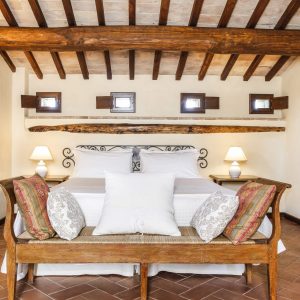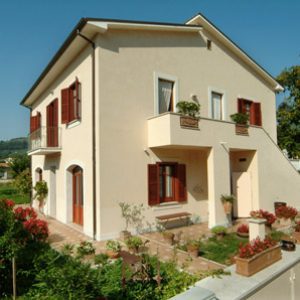▌ Alla scoperta di Arrone
#BELLAUMBRIA
Sul finire del sec. IX, un nobile romano di nome Arrone, inoltratosi nella Valnerina, si impossessò di uno dei promontori rocciosi che vi si ergevano e vi costruì un castello fortificato, inizialmente in legno e poi ricostruito in muratura.
>>Vuoi vedere Arrone? Consulta ora le offerte dei migliori hotel nelle vicinanze.
Questo castello fu il primo nucleo del paese, che prese da lui il nome. Il feudo in seguito giunse ad estendersi da Papigno a S. Pietro in Valle, da Miranda a Labbro, dal Lago di Piediluco a Melaci e a Polino. Durante il XIII secolo gli Arroni persero progressivamente terre, autonomia e prestigio in favore di Spoleto. Gli uomini di Arrone, allora, nel 1315, riscattarono tutto il territorio comunale dagli antichi signori, si dettero uno statuto (1542) e si fecero animatori della rivolta della Bassa Valnerina contro il sistema feudale spoletino (sec. XVII-XVIII). Incendiato e saccheggiato dai francesi nel 1799, con la restaurazione del governo pontificio, furono aggregate ad Arrone come frazioni comunità fino a quel momento autonome.
>> Ci sono offerte in scadenza per agriturismi in Valnerina! Clicca e consultale subito.
La parte alta dell’abitato conserva l’originale struttura medioevale, con le Antiche Mura, e i tipici stretti e pittoreschi vicoli. La vicinanza del paese al Fiume Nera ha permesso il prodursi di numerose manifestazioni ad esso legate quali gare di discesa in canoa, in natanti autocostruiti ecc che si tengono durante tutta l’estate. Da non perdere ad Arrone anche la rappresentazione del presepe vivente.
“},{“lang”:”en”,”content”:”
At the end of the 9th century, a Roman nobleman called Arrone, who had impossessed himself of the Valnerina valley, took over one of the rocky precipices which arise there, and constructed a fortified castle, originally made of wood and later reconstructed in stone.
This castle was the town’s first nucleus, and gave it its name. Later on, the feud was extended from Papigno to S. Pietro in Valle, from Miranda to Labro, from Lake Piediluco to Melaci and to Polino. During the 13th century, the inhabitants of Arrone continually lost more and more land, autonomy and prestige to Spoleto. Therefore, in 1315, the men of Arrone took over all the communal territory from the former lords, in 1542 gave themselves a statuteand promoted the ribellion of the lower Valnerina region against the feudal sistem of Spoleto (17th and 18th centuries). After having been burned and sacked by the French in 1799, townships which had been autonomous up until that time were ceded to Arrone with the reconstruction of the papal government.
The upper inhabited part of the town conserves the original medieval structure, with the old town walls and the typical narrow and picturesque lanes. Its vicinity to the river Nera has made possible the production of numerous events connected with the river, for example, competitions of descents in canoes, in self-constructed floating vessels etc., which are held during the summer season. Furthermore, don’t miss the representation of the living Nativity (creche) at Arrone.
“},{“lang”:”es”,”content”:”
At the end of the 9th century, a Roman nobleman called Arrone, who had impossessed himself of the Valnerina valley, took over one of the rocky precipices which arise there, and constructed a fortified castle, originally made of wood and later reconstructed in stone.
This castle was the town’s first nucleus, and gave it its name. Later on, the feud was extended from Papigno to S. Pietro in Valle, from Miranda to Labro, from Lake Piediluco to Melaci and to Polino. During the 13th century, the inhabitants of Arrone continually lost more and more land, autonomy and prestige to Spoleto. Therefore, in 1315, the men of Arrone took over all the communal territory from the former lords, in 1542 gave themselves a statuteand promoted the ribellion of the lower Valnerina region against the feudal sistem of Spoleto (17th and 18th centuries). After having been burned and sacked by the French in 1799, townships which had been autonomous up until that time were ceded to Arrone with the reconstruction of the papal government.
The upper inhabited part of the town conserves the original medieval structure, with the old town walls and the typical narrow and picturesque lanes. Its vicinity to the river Nera has made possible the production of numerous events connected with the river, for example, competitions of descents in canoes, in self-constructed floating vessels etc., which are held during the summer season. Furthermore, don’t miss the representation of the living Nativity (creche) at Arrone.
“},{“lang”:”fr”,”content”:”
Vers la fin du IXème siècle, un noble romain du nom d’Arrone, pénétrant dans la Valnerina, prit possession de l’un des promontoires rocheux qui s’érigeaient et y construit un château fortifié, initialement en bois et ensuite reconstruit en pierre.
Ce château fût le premier centre du village, qui en prit son nom. Le domaine ensuite arriva à s’étendre de Papigno à S. Pietro in Valle, de Miranda à Labbro, de Lac Piediluco à Melaci et à Polino.
Pendant le XIIIème siècle, les habitants d’Arrone perdent progressivement des terres, de l’autonomie et du prestige au bénéfice de Spoleto.
Les hommes d’Arrone, alors, en 1315, reprennent tout le territoire communal des antiques seigneurs, se dotent d’un statut (1542) et se font les animateurs de la révolte de la Basse Valnerina contre le système feudale de Spoleto (XVII-XVIIIème siècles). Incendiée et saccagée par les français en 1799, c’est avec la restauration du gouvernement pontifical que sont agrégées à Arrone en tant que fractions des communautés qui jusque-là étaient autonomes.
La partie haute du village a préservé sa structure médiévale d’origine, avec les Murs Antiques et les petites rues typiques du Moyen-Âge. La position voisine du village par rapport au fleuve Nera a permis la réalisation de nombreuses manifestations liées à ce dernier telles que des courses de descente en canoë, en bateaux construits de manière autonome, etc., qui ont lieu pendant l’été. A ne pas rater à Arrone: la représentation de la crèche vivante.
“},{“lang”:”de”,”content”:”
At the end of the 9th century, a Roman nobleman called Arrone, who had impossessed himself of the Valnerina valley, took over one of the rocky precipices which arise there, and constructed a fortified castle, originally made of wood and later reconstructed in stone.
This castle was the town’s first nucleus, and gave it its name. Later on, the feud was extended from Papig
no to S. Pietro in Valle, from Miranda to Labro, from Lake Piediluco to Melaci and to Polino. During the 13th century, the inhabitants of Arrone continually lost more and more land, autonomy and prestige to Spoleto. Therefore, in 1315, the men of Arrone took over all the communal territory from the former lords, in 1542 gave themselves a statuteand promoted the ribellion of the lower Valnerina region against the feudal sistem of Spoleto (17th and 18th centuries). After having been burned and sacked by the French in 1799, townships which had been autonomous up until that time were ceded to Arrone with the reconstruction of the papal government.
The upper inhabited part of the town conserves the original medieval structure, with the old town walls and the typical narrow and picturesque lanes. Its vicinity to the river Nera has made possible the production of numerous events connected with the river, for example, competitions of descents in canoes, in self-constructed floating vessels etc., which are held during the summer season. Furthermore, don’t miss the representation of the living Nativity (creche) at Arrone.
“}]}







